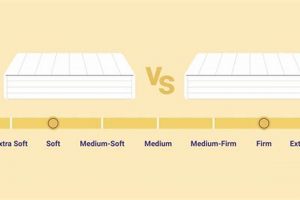The terms ‘single’ and ‘twin’ refer to mattress dimensions designed to accommodate one individual. Understanding these measurements is essential when selecting bedding, particularly for children’s rooms, guest rooms, or smaller living spaces where efficient use of area is prioritized. These mattresses are typically the smallest standard sizes available.
Choosing the correct mattress dimensions is important for optimizing sleep quality and comfort, especially in restricted spaces. Selecting an appropriate size influences room functionality and layout. Historically, these sizes have been fundamental in furnishing homes and institutions like dormitories and hospitals where space is limited.
The following sections will delve into a detailed comparison of these bed types, exploring their specific measurements, suitability for different users, and various factors to consider when deciding which option best meets individual needs and spatial constraints.
Selecting Appropriate Mattress Dimensions
Considerations during mattress selection influence sleep quality and efficient space utilization. The following tips offer guidance on determining the most suitable dimensions for various needs and circumstances.
Tip 1: Assess Room Dimensions. Prior to purchase, meticulously measure the available space. This ensures the selected mattress allows for comfortable movement around the room and avoids overcrowding.
Tip 2: Consider the Sleeper’s Size. Taller individuals may require the longer length of a twin XL mattress, despite its width being identical to a standard twin. This accommodates legroom and prevents discomfort.
Tip 3: Evaluate Budget Constraints. Mattress costs can vary significantly based on size and materials. Establish a clear budget to narrow down the options and avoid overspending.
Tip 4: Analyze User Requirements. A child’s needs differ from an adult’s. A younger child may be suitably accommodated by either option, while an older child or adult might benefit from the increased length of a twin XL, if space allows.
Tip 5: Factor in Bedding Availability. Ensure that sheets, comforters, and other bedding accessories are readily available in the selected size. This simplifies the furnishing process and avoids compatibility issues.
Tip 6: Think About Future Needs. Consider future growth or potential changes in living arrangements. Opting for a larger size might provide greater long-term flexibility.
Careful deliberation during the mattress selection process leads to enhanced comfort, efficient space management, and overall satisfaction with the purchase.
The subsequent sections will provide a concluding overview of the essential considerations discussed, reinforcing the importance of informed decision-making in this crucial aspect of home furnishing.
1. Width Comparison
Width comparison constitutes a fundamental aspect of differentiating between “mattress sizes single vs twin”. The primary distinction lies in the horizontal dimension, influencing the sleeper’s freedom of movement and overall comfort. While both are designed for individual occupancy, a variance in width directly affects the perceived spaciousness of the sleeping surface.
The consequences of ignoring the width differential manifest in restricted sleep positions, particularly for individuals who prefer to spread out or shift during sleep. For example, a broader individual might experience discomfort on a narrow mattress, impacting sleep quality. The significance of width is magnified in smaller rooms where even a few inches can influence the overall layout and accessibility of the space. This width becomes a crucial factor when one considers the sleeper’s dimensions along with the area of the room.
In summary, a meticulous assessment of width is paramount when deciding between “mattress sizes single vs twin”. This element directly correlates with sleep comfort and room functionality. Overlooking this comparison results in compromised sleep and less efficient use of available area. A broader mattress provides additional spaciousness, accommodating a wider range of sleeping positions, while a smaller option could be the suitable mattress size for small children.
2. Length Differences
The correlation between length differences and “mattress sizes single vs twin” manifests in the varying dimensions available to accommodate individuals of different heights. A standard twin mattress, for instance, typically measures shorter than a twin XL, a distinction directly impacting comfort for taller users. The cause and effect are straightforward: insufficient mattress length leads to discomfort and potentially disturbed sleep. This becomes a critical component in the selection of “mattress sizes single vs twin,” as it addresses the fundamental need for adequate physical support during sleep.
Consider the practical example of a growing teenager. A standard twin mattress, while initially sufficient, may become inadequate as the individual’s height increases. This necessitates a transition to a longer mattress, such as a twin XL, to prevent feet from hanging off the edge, thereby maintaining proper spinal alignment and promoting restful sleep. Similarly, in institutional settings such as dormitories, where space is often constrained, the length of the mattress must be carefully considered in relation to the average height of the student population.
In summary, understanding length differences within “mattress sizes single vs twin” is paramount for ensuring optimal sleep quality and physical well-being. Overlooking this factor presents challenges in achieving comfortable sleep, particularly for taller individuals. Recognizing and addressing the specific length requirements constitutes a vital aspect of informed mattress selection, ultimately linking directly to overall health and daily functionality.
3. Space Efficiency
Space efficiency constitutes a core consideration when evaluating “mattress sizes single vs twin.” The inherent dimensions of these mattress types directly influence their suitability for rooms with limited area. The choice between a single and twin mattress dictates the remaining usable space within a given room, affecting furniture placement and overall mobility. For instance, a smaller room benefits demonstrably from the compactness of either option, maximizing open area for other activities. The compromise between sleep comfort and space utilization must be carefully weighed.
Practical examples underscore this connection. In urban apartments, where square footage often comes at a premium, either of these mattresses offer a viable solution for bedrooms or guest rooms. Consider a child’s bedroom: employing either mattress dimension frees up valuable floor space for play and study. Conversely, in larger rooms, the difference in space savings between these two mattress types becomes less pronounced, potentially justifying a larger mattress for enhanced comfort. The decision hinges upon a critical assessment of room dimensions and occupant needs.
In conclusion, the relationship between “Space Efficiency” and “mattress sizes single vs twin” remains inextricably linked. Effective utilization of available area requires a comprehensive understanding of the dimensional variances between these mattress types. A failure to consider this connection results in inefficient room layouts and compromised living environments. The ultimate selection should reflect a conscious effort to balance comfort with spatial optimization.
4. User Suitability
The appropriateness of “mattress sizes single vs twin” is contingent upon diverse factors related to the individual user. Consideration must be given to height, weight, age, and specific sleep requirements to optimize comfort and ensure adequate support. These elements collectively define the suitability of each mattress type for a given individual.
- Age and Developmental Stage
Young children typically find either a single or twin mattress sufficient, providing ample space for comfortable sleep. However, as children grow, a twin mattress may offer a better long-term solution due to its slightly larger dimensions. This consideration avoids the need for premature mattress replacement as the child develops.
- Individual Size and Body Type
Taller individuals may experience discomfort on a standard single or twin mattress if their feet extend beyond the edge. In such cases, a twin XL mattress, offering additional length, provides a more suitable alternative. Furthermore, individuals with broader builds may benefit from the added width of a full-size mattress, although this deviates from the “mattress sizes single vs twin” comparison.
- Sleep Preferences and Habits
Individuals who tend to move frequently during sleep or prefer a wider sleeping surface may find either a single or twin mattress restrictive. Conversely, those who maintain a relatively still sleep posture may find either option adequate. These individual preferences directly influence the perceived comfort and suitability of each mattress size.
- Specific Health Considerations
Individuals with certain medical conditions, such as back pain, may require a mattress with specific support characteristics. While the dimensions of the mattress (“mattress sizes single vs twin”) do not directly address these needs, the underlying construction and materials play a crucial role. The choice of mattress type should therefore be informed by recommendations from healthcare professionals.
In summary, the selection between “mattress sizes single vs twin” necessitates a holistic evaluation of individual user attributes and requirements. Age, body type, sleep habits, and health considerations collectively dictate the optimal choice. Failure to adequately address these factors results in compromised sleep quality and potential discomfort. While individual circumstances vary, a thorough understanding of these considerations ensures informed decision-making and maximizes user satisfaction.
5. Cost Implications
The economic aspects inextricably linked to “mattress sizes single vs twin” influence purchase decisions. The initial acquisition cost represents a primary factor, with price variations often correlated to size. Smaller mattresses typically exhibit a lower price point, making them attractive options for budget-conscious consumers. Furthermore, long-term expenses associated with bedding, frames, and accessories must be considered within the overall cost analysis. The selection of “mattress sizes single vs twin” has a direct effect on the financial implications of furnishing a sleeping space.
Illustrative examples highlight this connection. Furnishing a dormitory room, where multiple beds are required, benefits financially from the lower cost per unit associated with either the “mattress sizes single vs twin”. Conversely, a guest room intended for occasional use might justify a higher investment in a larger mattress for enhanced comfort, despite the increased expense. The long-term cost of ownership, including potential replacement costs and the availability of affordable bedding, also plays a significant role. Choosing an uncommon size can lead to higher expenses related to specialty bedding.
In summary, the “Cost Implications” associated with “mattress sizes single vs twin” are multi-faceted, encompassing initial purchase price, long-term maintenance, and accessory costs. A comprehensive financial assessment ensures informed decision-making, balancing budgetary constraints with the desired level of comfort and durability. Overlooking the economic impact results in potentially unsustainable spending and compromised value. Prioritizing a cost-effective solution requires careful consideration of both immediate and future financial obligations.
Frequently Asked Questions
The following questions address common inquiries regarding mattress sizes, specifically focusing on single and twin dimensions. The information provided clarifies key differences and suitability factors.
Question 1: What are the precise dimensions of a standard single mattress?
The dimensions of a standard single mattress typically measure approximately 39 inches in width and 75 inches in length. This configuration offers a compact sleeping surface suitable for individual occupancy.
Question 2: How does the width of a twin mattress compare to that of a single mattress?
In most instances, a twin mattress possesses identical width dimensions to a single mattress, measuring approximately 39 inches. The terms are often used interchangeably.
Question 3: In what scenarios is a twin XL mattress preferable to a standard twin?
A twin XL mattress, distinguished by its extended length (approximately 80 inches), proves advantageous for taller individuals requiring additional legroom. This configuration prevents discomfort and promotes proper spinal alignment.
Question 4: What factors should be considered when selecting between a single and twin mattress for a child’s room?
Room size, the child’s age and growth rate, and budget constraints should be considered. Either option may suffice for younger children, but a twin may offer greater longevity as the child matures.
Question 5: Are bedding accessories interchangeable between single and twin mattresses?
In general, bedding accessories designed for single mattresses are compatible with standard twin mattresses due to their identical width dimensions. However, length must be considered when selecting fitted sheets.
Question 6: What is the typical cost differential between single and twin mattresses of comparable quality?
Cost variations between single and twin mattresses are usually minimal when comparing similar materials and construction quality. However, pricing can fluctuate based on brand, features, and retailer.
Careful consideration of these frequently asked questions ensures informed decision-making when selecting mattress dimensions. Understanding these key factors contributes to optimal comfort and efficient space utilization.
The subsequent section provides a concluding overview, summarizing the essential considerations discussed throughout this comprehensive exploration.
Concluding Remarks
This analysis of “mattress sizes single vs twin” has underscored critical distinctions relevant to both individual comfort and efficient space management. Key considerations include the subtle dimensional variances, user-specific suitability factors based on age and physical stature, and the economic implications associated with both initial purchase and long-term maintenance. A comprehensive understanding of these elements enables informed decision-making when selecting the appropriate mattress for specific needs and spatial constraints.
The selection of a mattress represents a long-term investment in sleep quality and overall well-being. Therefore, careful deliberation, factoring in the information presented, is essential. Future research into advanced mattress materials and ergonomic designs will likely further refine the selection process, enhancing the capacity to personalize sleep environments and optimize comfort levels. Continual awareness of these evolving factors remains paramount for maximizing satisfaction with mattress choices.


![Saatva vs Leesa Mattress: Which Bed Wins? [2024] Organic & Natural Mattress Buyer’s Guide: Non-Toxic Sleep Solutions Saatva vs Leesa Mattress: Which Bed Wins? [2024] | Organic & Natural Mattress Buyer’s Guide: Non-Toxic Sleep Solutions](https://mattressworldpa.com/wp-content/uploads/2025/07/th-1084-300x200.jpg)




